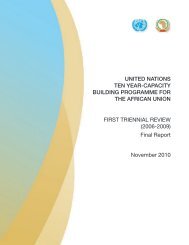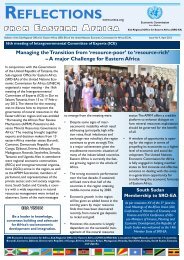Tool kit for Gender and Agriculture - Economic Commission for Africa
Tool kit for Gender and Agriculture - Economic Commission for Africa
Tool kit for Gender and Agriculture - Economic Commission for Africa
Create successful ePaper yourself
Turn your PDF publications into a flip-book with our unique Google optimized e-Paper software.
36<br />
Improving <strong>Agriculture</strong> through <strong>Gender</strong> Analysis<br />
• Activities selected⎯growing grapes <strong>and</strong> raising small livestock⎯were traditionally<br />
carried out by women.<br />
Results: The project has increased women’s income <strong>and</strong> agricultural production. In<br />
Hami, more than 60 percent of grape production is now contracted to women. In<br />
Zhaosu, <strong>for</strong> example, where women keep small ruminants, one participant has raised<br />
200 lambs <strong>and</strong> increased her income tenfold from 52 to 580 yuan/month. The benefits<br />
have not been confined to increased income. Women’s social st<strong>and</strong>ing has increased<br />
due to their ability to contribute to <strong>and</strong> increase family income. In addition, women in<br />
the Hami project attend literacy <strong>and</strong> technical classes in the off-season.<br />
Reasons <strong>for</strong> success: As part of overall assistance <strong>for</strong> poverty alleviation, the project<br />
followed the strategy of focusing on one of the poorer rural areas where most of the<br />
gender inequities prevailed. It opened up opportunities <strong>for</strong> women to participate in<br />
farm activities by promoting their access to productive resources. The activities chosen<br />
were economically viable. The project enabled women to contract l<strong>and</strong> <strong>and</strong> to produce<br />
grapes <strong>for</strong> raisin production. As a result, women grew more than 60 percent of grapes<br />
produced in the project area.<br />
c. Use of Project Conditionalities<br />
Project conditionalities that include references to gender should be:<br />
• Linked to resources to facilitate the achievement of the conditionality. For example,<br />
funds should be made available <strong>for</strong> actions such as training women students<br />
or offering gender awareness courses <strong>for</strong> men agents.<br />
• Realistic <strong>and</strong> adapted to local conditions. Task managers need to consider, <strong>for</strong><br />
example, what will happen if conditionalities⎯such as requiring that half of all<br />
new agents or half of the participants at public meetings be women⎯cannot be<br />
met (see Box 10).<br />
• Used with caution after careful assessment about the likelihood of their implementation.<br />
For example, how will the conditions be monitored <strong>and</strong> en<strong>for</strong>ced?







